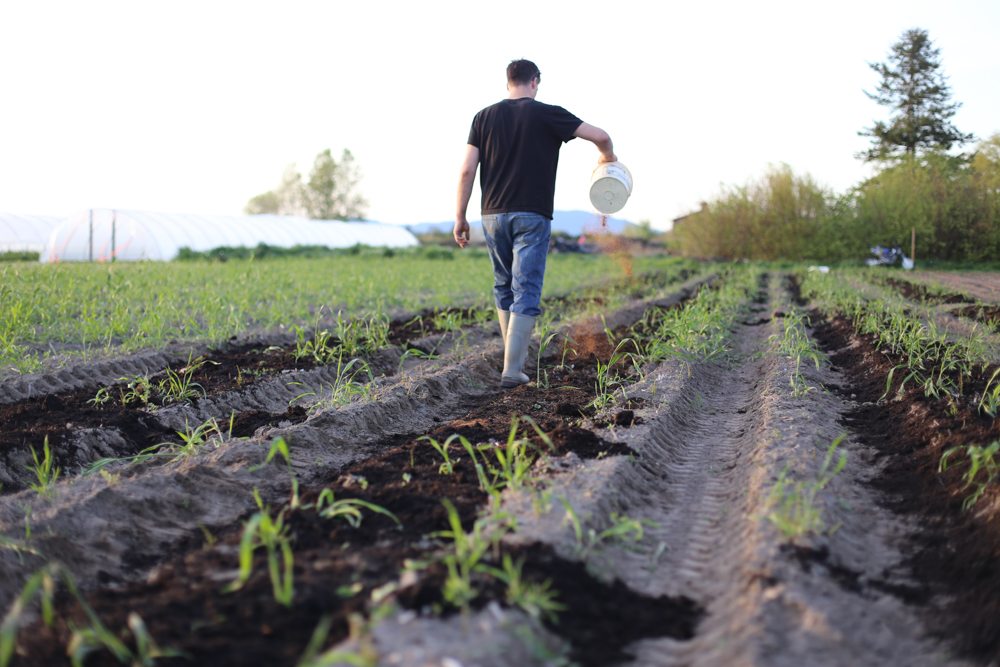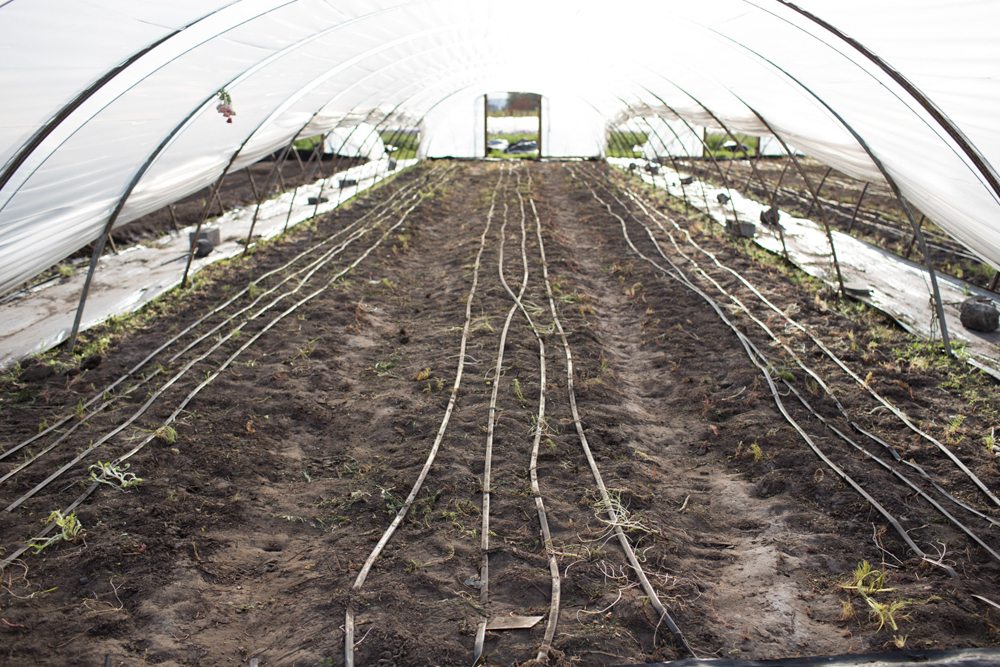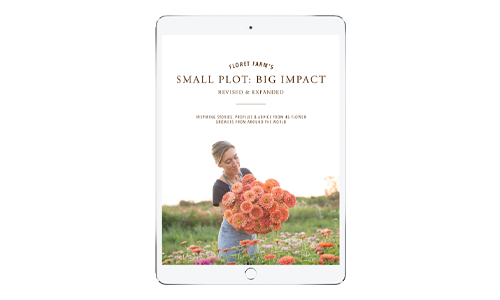Before we expanded our farm, we grew an insane number of flowers on our 2-acre plot of land. With so much beauty going out the door, we worked diligently not only to replace the biomass, but also to build and improve the soil every season. I’ve found that the old adage “you get out what you put in” sums up our approach to growing here at Floret.
Cover crops, compost, rock powders, natural fertilizers, mulch, compost tea, and various foliar treatments are all part of our fertility toolbox.
 Every fall, we take soil samples from our fields and greenhouses and send them to the local soil lab for testing. The information from the test gives us a broad overview of our soil health and what we can do to improve it. A good soil test normally runs less than $100—money well spent in the long run. This test measures everything from the percentage of organic matter to the pH of the soil, plus any lacking trace minerals.
Every fall, we take soil samples from our fields and greenhouses and send them to the local soil lab for testing. The information from the test gives us a broad overview of our soil health and what we can do to improve it. A good soil test normally runs less than $100—money well spent in the long run. This test measures everything from the percentage of organic matter to the pH of the soil, plus any lacking trace minerals.
A good lab will give you recommendations on which amendments to apply to bring your soil into good working order. I always make sure to let the lab know that we farm organically so they don’t suggest chemical fertilizers. Once we have the information back from the lab, we set about making necessary improvements. Fall is a great time to add rock powders and trace minerals so they’ll have time to dissolve into the soil before spring planting.
 Our farm is situated on top of a sandbar (note the silver shine to the soil shown above), and while its ability to drain freely is wonderful in early spring when most other fields are unworkable, it definitely comes with its own set of challenges. In addition to being very hungry, our soil has difficulty holding water and nitrogen. We add so much organic matter each year that I often feel as if we’re feeding an elephant.
Our farm is situated on top of a sandbar (note the silver shine to the soil shown above), and while its ability to drain freely is wonderful in early spring when most other fields are unworkable, it definitely comes with its own set of challenges. In addition to being very hungry, our soil has difficulty holding water and nitrogen. We add so much organic matter each year that I often feel as if we’re feeding an elephant.
In addition to applying the soil lab’s recommended nutrients in the fall, we also heavily amend each bed before planting in early spring and again each time we replant throughout the season. The same treatment goes for our greenhouse plantings.


 To start, we put down a thick 3- to 4-in (8- to 10-cm) layer of compost across the top of each bed, making sure to spread it out as evenly as possible. Our favorite compost is made locally from recycled plant debris. We purchase it by the dump truck load, and it runs $25 to $30 a yard, delivered. If you have heavier clay soil, you can cut the amount of compost you apply in half.
To start, we put down a thick 3- to 4-in (8- to 10-cm) layer of compost across the top of each bed, making sure to spread it out as evenly as possible. Our favorite compost is made locally from recycled plant debris. We purchase it by the dump truck load, and it runs $25 to $30 a yard, delivered. If you have heavier clay soil, you can cut the amount of compost you apply in half.
 We then sprinkle a generous dusting of a high-quality organic fertilizer at a rate of 1.5 lb per 10 linear ft (0.68 kg per 3 m) which, for us, is 10.5 lb per 70-ft-long (4.76 kg per 21.3-m) row.
We then sprinkle a generous dusting of a high-quality organic fertilizer at a rate of 1.5 lb per 10 linear ft (0.68 kg per 3 m) which, for us, is 10.5 lb per 70-ft-long (4.76 kg per 21.3-m) row.
One 50-lb (22.6-kg) bag covers about five of our 4- by 70-ft (1.2- x 21.3-m) growing beds.
Our favorite fertilizer is Nature’s Intent (7-2-4), which is made from natural ingredients including bonemeal, cottonseed meal, feather meal, kelp meal, and rock powders. It may not be available in your area, but you should be able to find something similar if you give the specifications to your local feed or garden store.

 We then till ingredients into the soil and lay irrigation lines. Because our soil is so sandy, we put down four lines of drip tape, 1 ft (30 cm) apart. If you have clay soil, you could probably get away with only two or three lines.
We then till ingredients into the soil and lay irrigation lines. Because our soil is so sandy, we put down four lines of drip tape, 1 ft (30 cm) apart. If you have clay soil, you could probably get away with only two or three lines.

 To control weeds, we cover most of our beds with landscape fabric that has preburned holes. Learn more about using landscape fabric to control weeds.
To control weeds, we cover most of our beds with landscape fabric that has preburned holes. Learn more about using landscape fabric to control weeds.
For beds that aren’t covered in landscape fabric, we mulch new plantings with straw, shredded leaves, or grass clippings to help retain moisture and suppress weeds. Once plants are in and growing, we feed them with a weekly application of compost tea.
After a bed of annual flowering plants such as bells of Ireland or snapdragons finishes producing, we mow the remaining foliage down and take up the fabric, pull back the drip irrigation lines, and amend the bed using the same process outlined above—before replanting with a second crop. In the fall, we clean up the beds and replant with a cover crop, usually a combination of rye grass, field peas, hairy vetch, and crimson clover.
While the process is labor-intensive, it has greatly increased the health of our plants on the farm, in turn upping our flower production across the board and decreasing insect and disease pressure.



 The hoop house pictured above was filled with Iceland poppies in the spring. Once the plants slowed their flowering to a trickle, we pulled them out, prepared the beds as described above, and replanted with a late crop of celosia.
The hoop house pictured above was filled with Iceland poppies in the spring. Once the plants slowed their flowering to a trickle, we pulled them out, prepared the beds as described above, and replanted with a late crop of celosia.
 I believe in using natural methods and ingredients when it comes to growing. In our valley, organic agriculture is slowly catching on, but there are still many farms that spray toxic chemicals on their crops and use synthetic fertilizers and other agrochemicals. I understand why. An organic approach requires more time, money, and steps. But in my opinion, if you have the choice, it’s worth considering.
I believe in using natural methods and ingredients when it comes to growing. In our valley, organic agriculture is slowly catching on, but there are still many farms that spray toxic chemicals on their crops and use synthetic fertilizers and other agrochemicals. I understand why. An organic approach requires more time, money, and steps. But in my opinion, if you have the choice, it’s worth considering.
From day one, we’ve only used natural ingredients in our gardens and on the farm. I don’t want to expose myself, our staff, visitors, or the creatures that live here to toxic chemicals.
But most importantly, my children have grown up in the garden, and I wanted their home and play areas to be safe and free from anything toxic or harmful.
I never could stomach the idea of exposing them to poisons just so I could get a perfect crop. Instead, I worked extra hard to grow the healthiest plants possible that could resist pests and disease on a diet of only natural ingredients.
At some point, children on the farm will probably come in contact with whatever you use in the soil and apply to your plants. And for all you animal lovers, the same is true for pets. Growing naturally is harder and a bit more expensive, but I truly believe it shows in the quality of the flowers and in your and your family’s health.
The photo below shows Jasper when he was little, spraying an early crop of spring flowers with compost tea, a safe, effective, and natural disease preventative.
 I would love to hear any questions you have about feeding your soil. What practices do you follow? Do you have any great resources relating to this topic that you’d be willing to share with others?
I would love to hear any questions you have about feeding your soil. What practices do you follow? Do you have any great resources relating to this topic that you’d be willing to share with others?
Please note: If your comment doesn’t show up right away, sit tight; we have a spam filter that requires us to approve comments before they are published.







Donna O'Malley on
We have LOVED all your videos – watching something about Floret has been the favorite thing my spouse and i do together on a weekend. May’s new monthly update was even more inspiring and I find myself more committed than ever to bringing in more flowers and also bringing the wild back to beyond-garden spaces. Along with a thank you, my question is ‘what do all flowers need most to produce their great gift of bloom?’ I’ve been a vegetable garden here in VT and know that different edibles have different nutrient needs, beyond the compost we add. I just found this answer how you prepare your soil for flowers – a powdered amendment of 7-2-4. Does that represent mostly the needs of your farm with your sandy soil, or can I assume we all need to attend to nitrogen and potash with a little less of a phosporous balance?